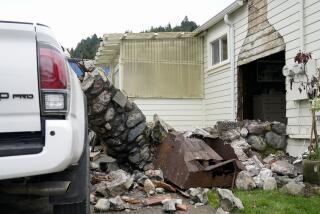New Technology May Cut Times the S.D. Weatherman’s All Wet
- Share via
By using this physical law (the Doppler effect) the new radar will be able to detect wind motion, tornadoes, and warm and cold fronts as they form, far earlier than present systems can.
San Diegans may continue to grumble about their weather when it’s not picture perfect, but they may over the next several years have fewer and fewer chances to complain about local forecasts missing the mark.
San Diego is targeted for a major upgrade of its National Weather Service office as a result of new radar and computer technology proposed for implementation nationwide by 1994.
Under the plan, the Weather Service office will be relocated from Lindbergh Field to Miramar Naval Air Station, which has been chosen for one of three, $1-million radar systems to be located in Southern California. The staff of meteorologists will be doubled to 20 and given complete responsibility for county forecasts, which now are largely put together in Los Angeles.
“The (proposed) changes involve not only a new radar (system), a new computer (system), but much different types of forecasts and responsibilities as the mission of the National Weather Service evolves,” said Wilbur Shigehara, meteorologist-in-charge at the San Diego office.
The plan, developed by the service’s national headquarters in Washington, must still be approved by its parent agency, the U.S. Department of Commerce, and funded by Congress. But the plan is expected to be implemented in some form because the new technology promises to improve forecasting significantly.
“The thrust of this thing is to take maximum advantage of new technology that is available now,” said Mark Fair, acting deputy director of the Weather Service’s western region in Salt Lake City. “The scientific understanding of the theory is well understood, and experimental equipment already developed shows that it will work.”
Current weather radar bounces energy waves off the water droplets that compose all clouds, and the intensity of the echo return indicates in general terms the severity of a storm and how much water it contains.
The new radar will be able to measure the movement of air as well, allowing far more accurate readings of storm intensity and direction. It is based on the Doppler effect, which says that the length of an energy wave will vary depending on whether the source being measured is moving away or toward the radar. By using this physical law, the new radar will be able to detect wind motion, tornadoes, and warm and cold fronts as they form, far earlier than present systems can.
The Doppler radar, already in limited use at some U.S. airports to detect wind shear conditions for pilots, will be accompanied by a sophisticated new computer system. That system will be able to process large amounts of radar information and integrate it with satellite, balloon and other measurements to spew out easy-to-understand maps and charts to use in forecasting.
To cover Southern California with overlapping Doppler radars, the Weather Service proposes to place one on a mountain near Ojai in Ventura County, one at Miramar, and one at Yuma on the California-Arizona border. Because of the tremendous amounts of data generated by the new system, the Weather Service wants forecast offices to be as close as possible--”preferably underneath” the radar, Fair said. The cost of transmitting the data along ground lines is high, Fair said.
“For the radar to work best, it needs to be positioned best, and that is why Miramar was chosen. . . . just standing at Miramar, you can look at most of San Diego without interference.”
A study for the Weather Service by Stanford Research Institute showed that placing the radar at Lindbergh Field would result in too much electronic clutter from nearby Navy and industrial facilities for optimum use.
Also, the new radar is paid for jointly by the Weather Service, the Federal Aviation Administration and the Pentagon.
“All share data and by placing the radar at Miramar, it gives us interesting options, such as combining the Navy weather office at Miramar and getting overall better use of information,” Fair said. “There’s are no negatives in plans for San Diego.”
Because of the new technology, “there’s a need to restructure (our office network) to handle it in the best way,” Fair said, adding that much of the surface data collection now reported manually--temperature, wind, air pressure--will be processed automatically.
Fair said that the new equipment will allow the Weather Service to decrease by two-thirds the number of meteorological technicians through attrition and retirement, and replace them with fully qualified meteorologists without increasing the total work force. That will allow more high-level analysis and better service to the public, he said.
“We will be able, for the same price, to staff an office with more forecasters, give them an incredible level of information about their area, and assign them major forecast responsibilities on a smaller (geographical) scale,” Fair said.
So the San Diego office will become a full-fledged weather forecasting office, upgraded from its current job of massaging regional forecasts done in Los Angeles. Los Angeles and other regional forecast offices, such as San Francisco and Salt Lake City, will now have smaller areas over which to apply the large increase in data, Fair said.
“There will be a lot more forecasting offices with complete responsibility for forecasts and warnings in their area,” Fair said. “And you will see significant improvements in forecasts, as well as in service for agriculture, and for aviation.”
More to Read
Sign up for Essential California
The most important California stories and recommendations in your inbox every morning.
You may occasionally receive promotional content from the Los Angeles Times.













